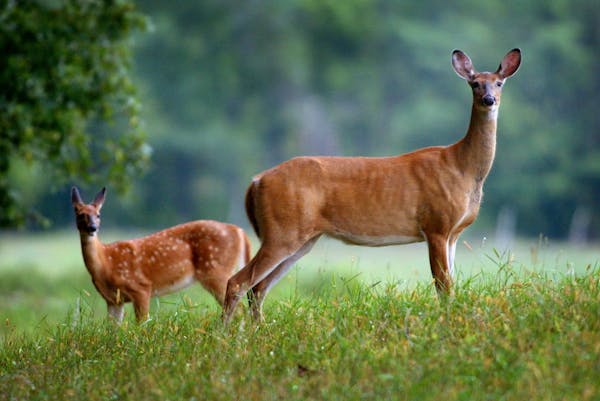With test results showing that two more deer in Fillmore County may have been carrying chronic wasting disease (CWD), state wildlife officials said Tuesday they are considering killing more whitetails than originally planned to stop the disease from spreading.
Michelle Carstensen, wildlife health program supervisor for the state Department of Natural Resources (DNR), said it was a "bummer'' to receive a preliminary finding of CWD in two more adult deer inside the agency's newly created CWD management zone. But she said there's still reason to believe the outbreak can be halted.
"We're going to figure this out and get rid of it,'' Carstensen said Tuesday.
Confirmation of the new cases would bring the total number of CWD-positive deer to five. The first two were killed by hunters last fall between Preston and Lanesboro and the third was killed last fall near the village of Bucksnort, east of Chatfield. All three of those animals were antlered bucks.
The two new cases are adult female deer that were traveling together last week when they were shot at the same time, by the same hunter. They were living near the area where the Preston-Lanesboro bucks were harvested, Carstensen said.
When the DNR late last year established its CWD management zone within a 10-mile radius of Preston, officials said they needed to test 900 adult deer to grasp the outbreak of fatal brain disease. It is only the second recorded outbreak of CWD in wild deer in Minnesota. In 2010, one infected whitetail was confirmed near Pine Island. In that case, an aggressive special hunt of 4,000 deer seemed to extinguish the disease.
Carstensen said that more than 900 adult deer may need to be killed now that new cases are suspected and because a recent aerial survey showed considerably more deer living in the management zone than originally thought. The aerial survey results estimated a total deer population for the area of 10,574 to 12,738 whitetails, with high densities of deer around the core areas where the first three CWD-positive deer were shot.
Carstensen said the DNR hasn't yet decided how many more deer should be killed.
"I don't know what 'more' is at this point,'' she said.
More tests will give the state a better assessment of CWD's prevalence in the area and possibly remove more infected deer from the population. Deer have to be dead to be tested for CWD and DNR collected 461 samples through Monday, 370 negatives, the two suspected cases and others pending.
The special season runs through Jan. 15. The next day, landowners in the zone can begin to harvest more deer under special permits. Five tags are issued to each landowner and more are available upon request. So far, the DNR has issued about 115 landowner shooting permits. And if that doesn't achieve the needed mortality, the DNR has said it could contract with sharpshooters to finish the hunt.
Carstensen said she and other biologists have been encouraged that all five deer confirmed or suspected with CWD looked normal and were not suffering from advanced symptoms. That could mean the outbreak is young and easier to curb, she said. It takes three years in most cases for CWD-infected deer, elk or moose to look visibly weak.
The DNR on Tuesday also re-emphasized a ban on citizens feeding deer in all of Fillmore, Houston, Mower, Olmsted and Winona counties. Also banned are attractants like salt blocks and commercially packaged deer urine, used by hunters as a lure.
The purpose of the bans are to reduce the number of deer concentration sites, where CWD can spread.
Carstensen said the DNR might never determine what started the Fillmore County CWD outbreak. She believes the disease entered the area by human-aided movement of deer, not from wild CWD-infected deer from infected regions of Wisconsin and Iowa. She said the disease could have spread from a commercial deer or elk farm; from a hunter killing a CWD-infected deer in another state and importing the carcass or from someone illicitly releasing a bio-engineered buck into the wild for hunting without knowing it was infected.
Carstensen said she's asked the Minnesota Board of Animal Health for information about any deer farms in the management zone that are out of business.
"We might not ever find out,'' she said.
